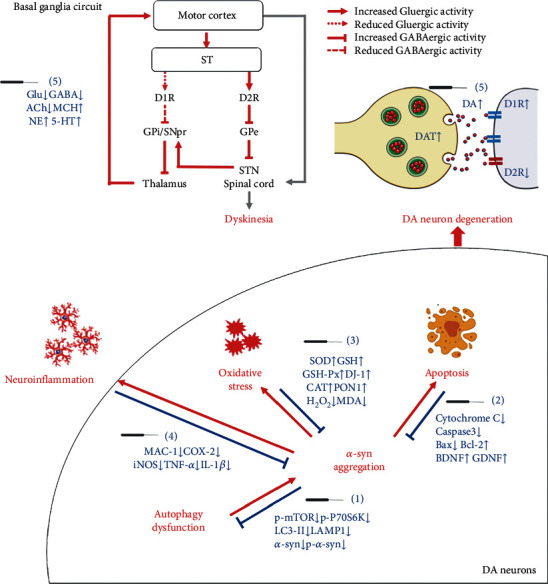Figure 2.

The neuroprotective mechanisms of acupuncture in the treatment of Parkinson's disease. The pathological activities associated with PD include α-syn aggregation, oxidative stress, apoptosis, neuroinflammation, and the disbalance of basal ganglia circuit (red). The key molecules (blue) in the above events are regulated by acupuncture to display neuroprotective effect in PD brain. ACh: acetylcholine; α-syn: α-synuclein; Bax: Bcl-2-associated X protein; Bcl-2: B cell lymphoma-2; BDNF: brain-derived neurotrophic factor; caspase-3: cysteinyl aspartate-specific proteinase-3; CAT: catalase; COX-2: cyclooxygenase-2; DA: dopamine; DAT: dopamine transporter; D1R: dopamine D1 receptor; D2R: dopamine D2 receptor; GABA: γ-aminobutyric acid; GDNF: glial cell-derived neurotrophic factor; Glu: glutamate; GPe: globus pallidus externus; GPi: globus pallidus internus; GSH: glutathione; GSH-Px: glutathione peroxidase; 5-HT: serotonin; IL-1β: interleukin-1β; iNOS: inducible nitric oxide synthase; LAMP1: lysosomal-associated membrane protein 1; LC3-II: microtubule-associated protein 1 light chain 3 II; MAC-1: macrophage antigen complex-1; MCH: melanin concentration hormone; MDA: malondialdehyde; NE: norepinephrine; p-α-syn: phosphorylated α-synuclein; p-mTOR: phosphorylated mammalian target of rapamycin; PON1: paraoxonase-1; p-p70S6k: phosphorylated ribosomal protein S6 kinase; SNpr: substantia nigra pars reticulate; SOD: superoxide dismutase; ST: striatum; STN: subthalamic nucleus; TNF-α: tumor necrosis factor-α.
